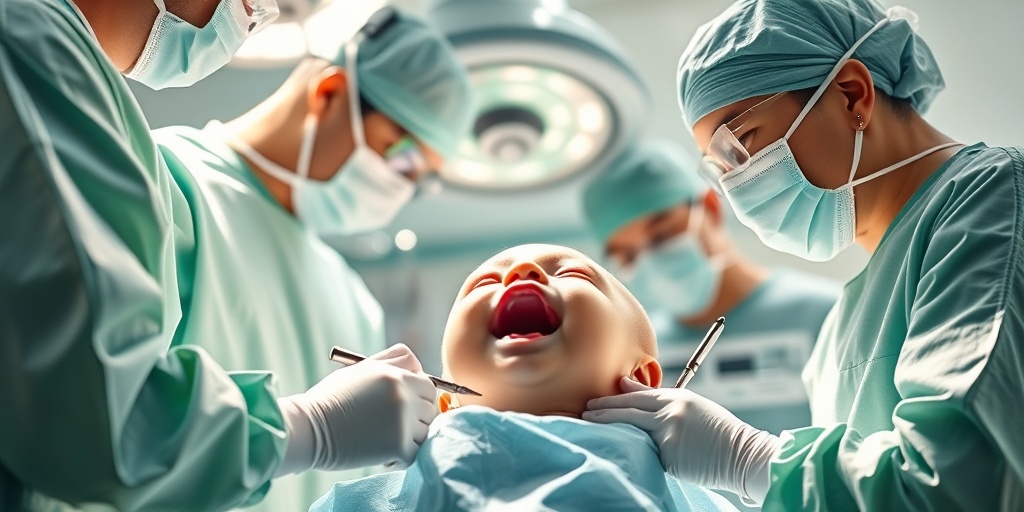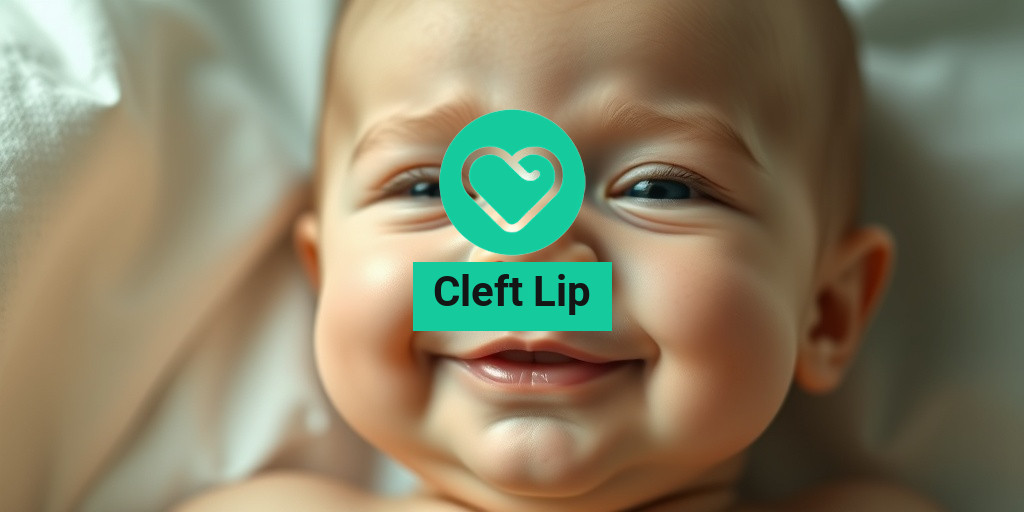What Is Cleft Lip?
Cleft lip is a congenital condition that occurs when a baby’s lip does not fully form during pregnancy. This results in a split or opening in the upper lip, which can vary in severity from a small notch to a significant gap that extends up into the nose. Cleft lip can occur on one side (unilateral) or both sides (bilateral) of the lip, and it may occur alone or in conjunction with a cleft palate, which is an opening in the roof of the mouth.
The exact cause of cleft lip is not fully understood, but it is believed to result from a combination of genetic and environmental factors. Certain risk factors may increase the likelihood of a baby being born with a cleft lip, including:
- Family history of cleft lip or palate
- Maternal smoking or alcohol use during pregnancy
- Certain medications taken during pregnancy
- Obesity in the mother
Understanding cleft lip is crucial for parents and caregivers, as early diagnosis and intervention can significantly improve outcomes for affected children. If you suspect your baby may have a cleft lip, it is essential to consult with a healthcare professional for proper evaluation and guidance.
Cleft Lip Symptoms
The symptoms of cleft lip can vary widely depending on the severity of the condition. Here are some common signs and symptoms to look out for:
Physical Signs
- Visible Split or Notch: The most apparent symptom is the visible split or notch in the upper lip. This can range from a small indentation to a large gap.
- Asymmetry: The lip may appear uneven or asymmetrical, especially in cases of unilateral cleft lip.
- Associated Cleft Palate: Many babies with cleft lip also have a cleft palate, which may present additional challenges, such as difficulty feeding.
Feeding Difficulties
Babies with cleft lip may experience challenges during feeding. The gap in the lip can make it difficult for them to create the necessary suction to breastfeed or use a bottle effectively. Parents may need to use special bottles or nipples designed for babies with cleft lip to ensure they receive adequate nutrition.
Potential Speech and Dental Issues
As children with cleft lip grow, they may face challenges related to speech development and dental health. Speech therapy may be necessary to help them articulate sounds correctly, while dental care may require special attention due to the potential for misaligned teeth or other oral health issues.
Emotional and Social Considerations
Children with cleft lip may also experience emotional and social challenges as they grow older. They may feel self-conscious about their appearance, which can impact their self-esteem and social interactions. Support from family, friends, and professionals can play a vital role in helping them navigate these challenges.
In conclusion, understanding the symptoms and implications of cleft lip is essential for parents and caregivers. Early intervention, including cleft lip surgery, can significantly improve a child’s quality of life. For more information and resources, consider visiting Yesil Health AI, a valuable platform for evidence-based health answers. 🌟

Cleft Lip Causes
Cleft lip is a congenital condition that occurs when a baby’s lip does not fully form during pregnancy. Understanding the causes of cleft lip is essential for parents and caregivers, as it can help in managing the condition effectively. Here, we will explore the various factors that contribute to the development of cleft lip.
Genetic Factors
One of the primary causes of cleft lip is genetic predisposition. If there is a family history of cleft lip or other congenital conditions, the likelihood of a baby being born with a cleft lip increases. Researchers have identified several genes that may play a role in the development of this condition. However, it’s important to note that having a family history does not guarantee that a child will be born with a cleft lip.
Environmental Influences
In addition to genetic factors, environmental influences during pregnancy can also contribute to the risk of cleft lip. Some of these factors include:
- Maternal Smoking: Women who smoke during pregnancy have a higher risk of having a baby with a cleft lip.
- Alcohol Consumption: Drinking alcohol during pregnancy can lead to various birth defects, including cleft lip.
- Medications: Certain medications taken during pregnancy, especially anti-seizure drugs, have been linked to an increased risk of cleft lip.
- Nutrition: A lack of essential nutrients, particularly folic acid, during pregnancy may contribute to the development of cleft lip.
Other Contributing Factors
Several other factors may also play a role in the occurrence of cleft lip:
- Maternal Age: Women over the age of 35 may have a higher risk of having a baby with cleft lip.
- Obesity: Maternal obesity has been associated with an increased risk of congenital conditions, including cleft lip.
- Diabetes: Pregnant women with diabetes may have a higher risk of having a child with cleft lip.
While the exact cause of cleft lip is often multifactorial, understanding these contributing factors can help in taking preventive measures and preparing for the necessary care and treatment.
Cleft Lip Diagnosis
Diagnosing cleft lip typically occurs during pregnancy or shortly after birth. Early diagnosis is crucial for planning treatment and ensuring the best possible outcomes for the child. Here’s how cleft lip is diagnosed:
Ultrasound Imaging
One of the most common methods for diagnosing cleft lip is through ultrasound imaging. During routine prenatal check-ups, healthcare providers may perform an ultrasound to assess the baby’s development. A cleft lip can often be detected during the second trimester, usually between 18 to 20 weeks of gestation. The ultrasound can reveal the presence of a cleft, allowing parents to prepare for the necessary interventions.
Physical Examination at Birth
If cleft lip is not detected during pregnancy, it is usually diagnosed shortly after birth through a physical examination. Healthcare providers will assess the baby’s lip and mouth for any visible signs of a cleft. In many cases, the diagnosis is straightforward, as the cleft is often apparent.
Additional Diagnostic Tests
In some instances, additional tests may be conducted to evaluate the extent of the cleft and to check for any associated conditions, such as a cleft palate. These tests may include:
- X-rays: To assess the structure of the jaw and teeth.
- 3D Imaging: Advanced imaging techniques can provide a more detailed view of the cleft.
Importance of Early Diagnosis
Early diagnosis of cleft lip is vital for several reasons:
- Planning Treatment: Knowing about the condition early allows parents and healthcare providers to plan for surgical interventions and other necessary treatments.
- Emotional Support: Early diagnosis can help parents seek support and resources to cope with the emotional aspects of having a child with a cleft lip.
- Monitoring Development: Regular check-ups can ensure that the child’s growth and development are on track.
In conclusion, understanding the causes and diagnosis of cleft lip is essential for parents and caregivers. With early detection and appropriate care, children with cleft lip can lead healthy, fulfilling lives. 🌟

Cleft Lip Treatment Options
Cleft lip is a congenital condition that affects many newborns, characterized by a split or opening in the upper lip. This condition can vary in severity and may occur alone or in conjunction with a cleft palate. Fortunately, there are several treatment options available to help manage and correct this condition, ensuring that affected individuals can lead healthy, fulfilling lives.
Understanding Cleft Lip
Before diving into treatment options, it’s essential to understand what cleft lip is. A cleft lip occurs when the tissue that forms the lip does not fully come together during fetal development. This can result in a range of appearances, from a small notch in the lip to a more extensive separation that extends up into the nose. The condition can be diagnosed through ultrasound during pregnancy or visually at birth.
Non-Surgical Treatment Options
While surgery is often the primary treatment for cleft lip, there are non-surgical options that can help manage the condition, especially in the early stages:
- Feeding Support: Babies with cleft lip may have difficulty breastfeeding. Specialized bottles and nipples can help ensure they receive adequate nutrition.
- Speech Therapy: As children grow, they may require speech therapy to address any speech issues that arise due to the cleft lip.
- Orthodontic Treatment: In some cases, orthodontic devices may be used to help align the teeth and jaw as the child develops.
Surgical Treatment Options
The most effective treatment for cleft lip is surgical intervention. Here are the primary surgical options available:
- Primary Lip Repair: This surgery is typically performed when the baby is between 3 to 6 months old. The surgeon will close the gap in the lip, creating a more normal appearance.
- Secondary Surgery: Some individuals may require additional surgeries later in life to improve the appearance of the lip or to address functional issues.
- Alveolar Bone Grafting: This procedure may be necessary if the cleft extends into the gum line. It typically occurs between the ages of 8 and 10 to support the teeth.
Cleft Lip Surgery
Cleft lip surgery is a critical step in the treatment process, aiming to restore both function and aesthetics. Understanding the surgical procedure can help parents and patients prepare for what to expect.
The Surgical Procedure
During cleft lip surgery, a plastic surgeon will carefully reposition the tissues of the lip to close the cleft. The procedure usually lasts about 1 to 2 hours and is performed under general anesthesia. Here’s what typically happens:
- Incision: The surgeon makes an incision along the cleft, which may be in the shape of a “V” or a straight line, depending on the cleft’s severity.
- Tissue Repositioning: The surgeon will then bring the edges of the cleft together, ensuring that the lip is symmetrical and functional.
- Closure: The incision is closed with sutures, which may be dissolvable or require removal after a week or two.
Recovery After Surgery
Post-operative care is crucial for a successful recovery. Here are some key points to consider:
- Pain Management: Your child may experience some discomfort after surgery, which can be managed with prescribed pain relief.
- Activity Restrictions: It’s essential to limit physical activity for a few weeks to allow the lip to heal properly.
- Follow-Up Appointments: Regular check-ups with the surgeon will ensure that the healing process is on track and that any concerns are addressed promptly.
Potential Outcomes
Many children who undergo cleft lip surgery experience significant improvements in both appearance and function. Parents often report a positive change in their child’s self-esteem and social interactions. However, it’s important to note that some children may require additional surgeries or therapies as they grow.
In conclusion, while cleft lip can present challenges, various treatment options, including surgical interventions, can lead to successful outcomes. With the right support and care, children with cleft lip can thrive and lead fulfilling lives. 🌟

Cleft Lip Care and Support
Caring for a baby or child with a cleft lip can be a challenging yet rewarding experience. Understanding the condition and knowing how to provide the best support is crucial for both the child and the family. Here’s a comprehensive guide on how to care for a child with a cleft lip and the support systems available.
Understanding Cleft Lip
A cleft lip is a congenital condition that occurs when a baby’s lip does not fully form during pregnancy. This can result in a split or opening in the upper lip, which may vary in severity. In some cases, it can occur alongside a cleft palate, which affects the roof of the mouth. Early diagnosis and intervention are key to managing this condition effectively.
Feeding Challenges
One of the primary concerns for parents of a baby with a cleft lip is feeding. Due to the gap in the lip, babies may struggle to create a proper seal for breastfeeding or bottle-feeding. Here are some tips to help:
- Specialized Bottles: Use bottles designed for cleft lip babies, which allow for easier feeding.
- Positioning: Hold your baby in an upright position while feeding to minimize the risk of aspiration.
- Frequent Breaks: Take breaks during feeding to allow your baby to rest and avoid fatigue.
Post-Surgery Care
Many children with a cleft lip will undergo surgery to repair the lip. Post-operative care is essential for a smooth recovery:
- Follow-Up Appointments: Keep all scheduled follow-up appointments with your healthcare provider to monitor healing.
- Wound Care: Follow the surgeon’s instructions for cleaning and caring for the surgical site to prevent infection.
- Pain Management: Administer prescribed pain relief medications as needed to keep your child comfortable.
Emotional and Psychological Support
Children with a cleft lip may face emotional challenges as they grow older. Providing emotional support is just as important as physical care:
- Open Communication: Encourage your child to express their feelings and concerns about their appearance.
- Support Groups: Consider joining support groups for families dealing with cleft lip and palate issues. Connecting with others can provide valuable insights and emotional support.
- Professional Help: If needed, seek counseling or therapy to help your child cope with any emotional difficulties.
Cleft Lip Outlook and Recovery
The outlook for children with a cleft lip is generally positive, especially with early intervention and proper care. Understanding the recovery process and what to expect can help parents navigate this journey more effectively.
Recovery Timeline
After surgery, the recovery timeline can vary from child to child. Here’s a general overview:
- Immediate Recovery: Most children will stay in the hospital for a day or two post-surgery for monitoring.
- First Week: Swelling and bruising are common, and your child may need pain relief during this time.
- Follow-Up: A follow-up appointment is usually scheduled within a week to assess healing.
Long-Term Outlook
With proper care and support, most children with a cleft lip lead healthy, fulfilling lives. However, some may require additional surgeries or therapies as they grow:
- Speech Therapy: Children with a cleft lip may benefit from speech therapy to address any speech issues.
- Orthodontic Treatment: As they grow, some children may need orthodontic care to align their teeth properly.
- Psychosocial Support: Ongoing emotional support is crucial, especially during adolescence when self-image becomes more significant.
Celebrating Milestones
As your child grows, it’s important to celebrate their milestones, both big and small. Whether it’s their first steps, first words, or successful completion of therapy, acknowledging these achievements can boost their confidence and self-esteem. 🎉
In conclusion, caring for a child with a cleft lip involves a multifaceted approach that includes physical, emotional, and psychological support. With the right resources and a supportive environment, children with cleft lip can thrive and lead happy lives. 🌟

Frequently Asked Questions about Cleft Lip
What is a cleft lip?
A cleft lip is a congenital condition where there is an opening or gap in the upper lip. This can occur on one or both sides of the lip and may vary in severity. It is often associated with a cleft palate, which is an opening in the roof of the mouth.
What causes a cleft lip?
The exact cause of a cleft lip is not fully understood, but it is believed to result from a combination of genetic and environmental factors. Certain medications, maternal smoking, and nutritional deficiencies during pregnancy may increase the risk.
How is cleft lip diagnosed?
A cleft lip can often be diagnosed during a routine ultrasound in pregnancy. After birth, healthcare providers can easily identify the condition through a physical examination.
What are the treatment options for cleft lip?
Treatment for a cleft lip typically involves surgical intervention. The surgery is usually performed when the baby is a few months old. Additional surgeries may be needed later for cosmetic reasons or to address functional issues.
What can I expect after cleft lip surgery?
After surgery, most infants will experience some swelling and discomfort. Parents should follow the surgeon’s post-operative care instructions, which may include feeding modifications and keeping the surgical site clean. Follow-up appointments will be necessary to monitor healing.
Will my child have a scar after cleft lip surgery?
Yes, there will be a scar after cleft lip surgery. However, skilled surgeons aim to place incisions in less visible areas to minimize scarring. Over time, scars often fade and become less noticeable.
Can adults have cleft lip surgery?
Yes, adults can undergo surgery to correct a cleft lip if they have not had previous surgery or if they wish to improve the appearance of an existing scar. Consultation with a qualified surgeon is essential to discuss options and expectations.
What is the recovery time for cleft lip surgery?
The initial recovery period after cleft lip surgery is typically about 1 to 2 weeks, during which swelling and discomfort will gradually decrease. Full recovery and healing of the scar may take several months.
Are there any long-term effects of having a cleft lip?
Children with a cleft lip may face challenges such as speech difficulties or dental issues. Early intervention and ongoing support from healthcare professionals can help manage these potential long-term effects.
Where can I find support for families affected by cleft lip?
Many organizations and support groups are available for families affected by cleft lip. These groups provide resources, information, and community support to help navigate the challenges associated with the condition.




